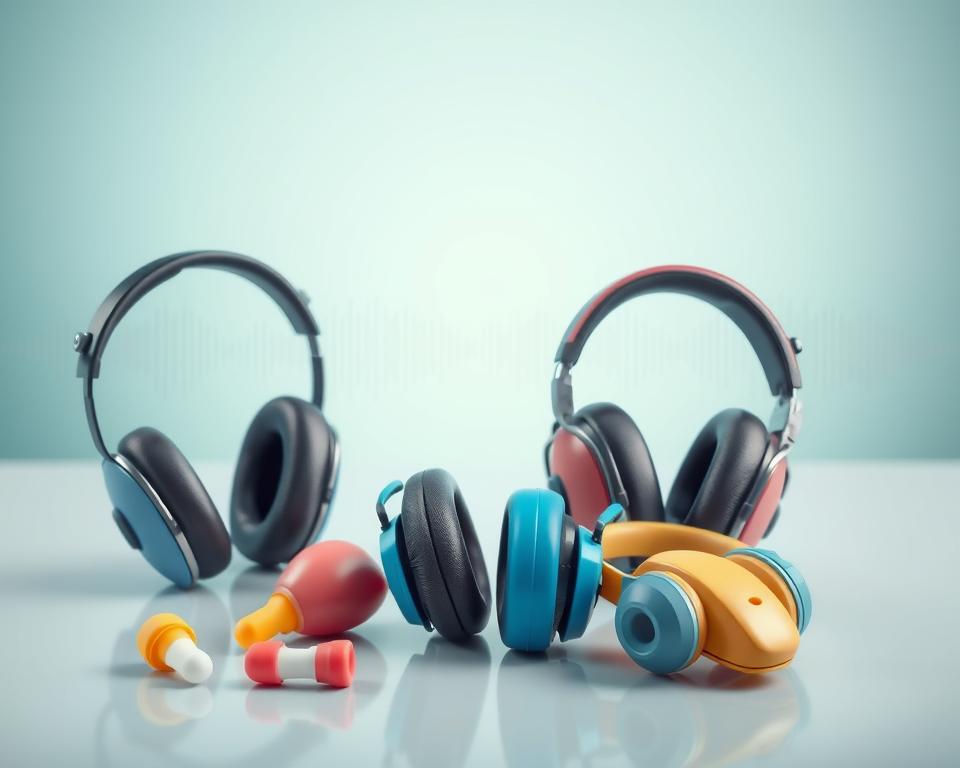Could your hearing protection be giving you a false sense of security? In Australia, workplace hearing safety is not just a matter of company policy but a crucial aspect of worker welfare. With machinery often pushing sound pressure levels to the point where hearing protection is non-negotiable, it’s vital to ask: Are you selecting appropriate hearing protection that meets your workplace noise challenges?
In line with Safe Work Australia’s standards, where 85 decibels (dB(A)) over eight hours can be the threshold for hearing damage, employers must implement an effective hearing conservation program. Yet research reveals that in many real-world scenarios, workers are only achieving about 6 dB of noise reduction with earplugs, falling short of even modest protection goals.
Our guide engages with the nuances of Australian Standards 1270, the benchmark for ensuring that your selection aligns with the legislative requirements for hearing protection devices. With noise levels in a bustling workshop registering at 40dB(A), but a jump to 85dB(A) or higher posing serious risks, it is essential to understand the dynamics of workplace hearing safety.
The question is not just about which device to wear but also about how to wear it correctly—poorly fitted earplugs may offer little protection, a concern highlighted by Standard AS/NZS 1269.3:2005. Given the stark variance in individual ear canal sizes and shapes, factors such as fit testing become pivotal in safeguarding against noise-induced hearing loss.
So, whether you’re weighing the attenuation capacities of Class 5 level earplugs against the convenience of earmuffs, or considering if Active Noise Cancellation (ANC) technology provides the necessary reduction without hindering communication, the importance of selecting appropriate hearing protection cannot be overstated. In this guide, we delve into the critical decisions that will shape your hearing conservation program and enhance the auditory well-being of your workforce.
With our ears attuned to the latest guidelines and the collective wellbeing of workers in mind, we invite you to explore the complexities of workplace hearing safety through our comprehensive insights. Choose protection that resonates with safety, comfort, and clarity—because when it comes to hearing conservation, every decibel matters.
Understanding the Australian Standards for Hearing Protection
In the context of occupational health and safety, adhering to standards like AS/NZS 1270:2002 is crucial for ensuring that hearing protection devices provide the necessary noise reduction to safeguard employees’ hearing. Understanding these standards helps in making informed decisions about hearing protection selection.
The Importance of AS/NZS 1270:2002 Compliance
Compliance with the AS/NZS 1270:2002 standard is essential for all hearing protection products used in Australia and New Zealand. This standard outlines the performance criteria that must be met to ensure adequate protection against harmful noise levels in various working environments. It categorizes hearing protectors based on their Noise Reduction Ratings (NRR), which indicate how effective a device is at dampening environmental noise.
Reading the Noise Reduction Ratings on Packaging
The Noise Reduction Ratings (NRR) found on the packaging of hearing protection devices inform users about the level of sound attenuation offered. The NRR score is crucial for users to understand the extent of noise reduction provided, ensuring that selected protectors are appropriate for their specific work conditions. Employers and safety officers must ensure that all hearing protectors comply with these ratings to maintain a safe auditory environment.
Class Ratings and Their Significance in Hearing Protector Selection
Hearing protectors are classified from Class 1 to Class 5, with each class representing different levels of noise protection. Understanding these Class 1 to Class 5 protectors is integral to selecting the right type of hearing protection based on the specific noise levels in a workplace. The classification helps users easily identify the level of protection required to safely handle their exposure to noise.
| Class Rating | Noise Level Protection (dB) | Work Environment Suitability |
|---|---|---|
| Class 1 | Less than 90 dB | Low-noise environments (e.g., libraries) |
| Class 2 | 90-95 dB | Medium-noise environments (e.g., office with machinery) |
| Class 3 | 95-100 dB | High-noise environments (e.g., manufacturing plants) |
| Class 4 | 100-105 dB | Very high-noise environments (e.g., heavy machinery) |
| Class 5 | 105-110 dB | Extremely high-noise environments (e.g., airports, mining) |
Selecting the appropriate class of protector ensures effective mitigation of noise risks, complying with safety regulations and maintaining auditory health standards in the workplace.
Identifying the Risks: Workplace Noise Assessment
In the ever-evolving landscape of occupational health and safety, Workplace Noise Assessment stands as a critical component in mitigating risks associated with noise exposure. Accurately identifying and assessing noise levels is indispensable for crafting effective Noise Control Workplace strategies. This involves a comprehensive process of data collection, analysis, and implementation of corrective measures tailored to specific workplace environments.
Establishing Baseline Noise Levels in the Work Environment
The initial step in a Workplace Noise Assessment is to establish baseline noise levels. This quantifies the prevailing ambient noise and identifies sources of excessive noise. By employing sophisticated measuring devices, businesses can gather accurate data on noise exposure levels, which is crucial for further assessment and control measures. This phase is instrumental in determining the scope and necessity for personal hearing protection and other noise mitigation strategies.
Assessing the Duration and Intensity of Noise Exposure
Following the establishment of baseline noise levels, the next pivotal step is analyzing the duration and intensity of noise exposure. This assessment helps in understanding the time frames during which employees are exposed to high decibel levels and is crucial for scheduling work to minimize hearing assessments workplace hazards. Implementing rotational work shifts or installing noise barriers can significantly aid in reducing overall exposure, thereby protecting employee hearing.

Through meticulous Workplace Noise Assessment, organizations not only comply with health and safety regulations but also enhance workplace productivity and morale by ensuring a safer, quieter environment. Addressing high noise levels with adequate mitigation measures like using earmuffs or earplugs, as recommended by workplace noise assessments, directly reflects a commitment to employee health and occupational safety standards.
Selecting Appropriate Hearing Protection
When it comes to safeguarding your hearing within noisy environments, understanding how to select the best ear protection is crucial. Whether you’re frequenting a construction site or stationed in a manufacturing plant, the right choosing hearing defenders can significantly impact your long-term auditory health.
Key Factors in Hearing Protection Selection
- Compatibility with other safety equipment
- Comfort and fit over extended use
- Appropriate noise reduction according to environment specifics
- Compliance with Australian safety standards
Before you invest in hearing conservation products, ensure they adhere to the stringent Australian Standard 1270, which dictates the effectiveness of hearing protectors in mitigating occupational noise risks. If you are navigating through earmuffs selection or figuring out how to pick earplugs, this standard acts as a reliable precautionary measure to guide your choices.
Here are practical highlights to consider:
| Environment | Recommended Protection Type | Sound Levels |
|---|---|---|
| Construction Sites | Earmuffs | 85-100 dBA |
| Manufacturing Facilities | Earplugs | Less than 85 dBA |
| Music Events | High-Fidelity Earplugs | 100+ dBA |
For peak noise levels such as those generated by chainsaws or jackhammers, exceeding 100 dBA, wearing both earmuffs and earplugs together—a method known as double protection—is advised to achieve optimal auditory safety.

Moreover, while earplugs may offer versatility and comfort, especially in hotter climates, they need precise fitting to deliver the expected protection. On the other hand, earmuffs provide ease of use and can be more durable, representing a higher initial investment but less frequent replacements.
It’s essential that whatever choice you make regarding hearing protection, consistent and correct usage is key to effective hearing conservation. Visit how to pick earplugs and other protective equipment to understand better how sound levels in your specific working environment align with the protection offered by different devices.
Remember, protecting your hearing is a proactive measure that not only preserves your quality of life but also complies with occupational safety obligations. Choosing the right equipment involves both understanding the hazards present and selecting a product that meets necessary safety standards and personal comfort.
Earplugs vs. Earmuffs: A Comparative Overview
Choosing the right hearing protection means weighing up the advantages of earplugs vs. earmuffs. These hearing protection devices serve as critical defenders against hazardous noise levels that can lead to noise-induced hearing loss (NIHL), a prevalent concern in various Australian industries. The occupational exposure limit for noise is typically set at 85 decibels (A-weighted) or dBA, a benchmark at which employers must implement a hearing conservation program. This program is inclusive of noise assessment, employee training, audiometric testing, and regular program evaluation to ensure worker safety.
When to Choose Earplugs Over Earmuffs
In environments with noise levels below 105 dBA, earplugs can be a suitable form of hearing defence, offering up to 50% of the noise reduction ratings (NRR). Due to their less visible profile, they are favorable in circumstances that demand subtlety while protecting one’s hearing. They are particularly advantageous for individuals who work in intermittent noise exposure settings, as earmuffs are relatively easier to remove and reinsert. However, in areas where noise exceeds 105 dBA, earmuffs are generally recommended for their capacity to achieve up to 70% of the NRR, providing a level of noise reduction earplugs cannot match. Also, for the ultimate protection, dual protection, combining both earplugs and earmuffs, can achieve an NRR of 65%.
Evaluating the Fit and Comfort of Different Earmuff Styles
When choosing hearing defenders, it is imperative to consider both the fit and comfort of the device. Earmuffs come in various styles, each designed to cater to the unique contours of users’ heads, whether they wear glasses, have facial hair, or possess diverse facial structures. A systematic review involving 3971 articles with a focus on the effectiveness of hearing protection devices indicated a significant effectiveness, achieving a standardized mean difference (SMD) of 0.457. Despite the higher cost and potential discomfort in hotter work areas, earmuffs remain a robust choice for noise reduction, particularly in environments where noise levels fluctuate, as they can be easily taken off and then re-worn as needed.
Studies have shown that effective usage of these devices not just curbs the immediate risks associated with high decibel environments but also contributes long-term to the reduction of noise-induced hearing loss cases among industrial workers and military personnel. Therefore, whether selecting earplugs or earmuffs, it is crucial to consider the specific requirements of the workplace, the Noise Reduction Ratings, and the comfort needs of the user to ensure auditory health is maintained at the highest standard.
FAQ
What is the guide to selecting appropriate hearing protection in Australia?
The guide provides information on choosing the right hearing protection devices by considering factors like workplace noise levels, comfort, fit, and Australian standards (AS/NZS 1270:2002) to ensure workplace hearing safety and prevent noise-induced hearing loss as part of a hearing conservation program.
Why is AS/NZS 1270:2002 compliance important?
Compliance with AS/NZS 1270:2002 ensures that hearing protection devices meet Australian standards for noise reduction capabilities. This is essential for providing adequate protection in environments with specific noise exposure levels.
How do I read the Noise Reduction Ratings on packaging?
Noise Reduction Ratings (NRR) on the packaging indicate the level of sound reduction a hearing protection device can provide. It’s essential to match the NRR with the noise levels in your workplace to ensure suitable protection.
What do Class Ratings mean in hearing protector selection?
Class Ratings, ranging from Class 1 to Class 5, signify the level of noise protection a hearing device offers. Class 1 provides the least amount of protection, while Class 5 offers the highest. Selecting the appropriate class depends on the noise exposure levels in the workplace.
How do you establish baseline noise levels in a work environment?
Baseline noise levels are established through a workplace noise assessment, which includes measuring the intensity and duration of noise exposure throughout different areas and times. These assessments are vital for determining the necessary level of ear protection.
Why is assessing the duration and intensity of noise exposure important?
Assessing the duration and intensity of noise exposure helps identify employees’ risk of hearing damage. This information is crucial to selecting the most appropriate hearing protection for their specific work conditions.
What should I consider when selecting the best ear protection?
When selecting the best ear protection, consider the specific noise reduction needs of your work environment, the fit and comfort of the hearing device, its compatibility with other safety equipment, and its conformity to Australian standards for noise reduction.
When should I choose earplugs over earmuffs?
Earplugs should be chosen over earmuffs when you need protection in environments where lower-class protection is sufficient, or in conditions where earmuffs are not practical due to other personal protective equipment or preferences.
How do I evaluate the fit and comfort of different earmuff styles?
To evaluate the fit and comfort of different earmuff styles, try on several options to test for a secure fit without excessive pressure, check if they accommodate glasses or facial hair, and ensure they provide the necessary noise reduction without causing discomfort during extended use.
Source Links
- Sound advice: choosing hearing protection – Australian Wood Review
- Hearing Protection Fit Testing in Australia
- How to Choose The Right Hearing Protection – part 3
- The Best Packaging, Safety & Washroom Supplies
- What you need to know when choosing hearing protection
- Hearing personal protective equipment (PPE) – The facts
- Controlling hazardous noise in the workplace
- Three Tips for Choosing the Right Hearing Protector | Blogs
- Hearing Protectors
- Personal hearing protectors – selection
- Hearing Protectors
- The Effectiveness of Hearing Protection Devices: A Systematic Review and Meta-Analysis

